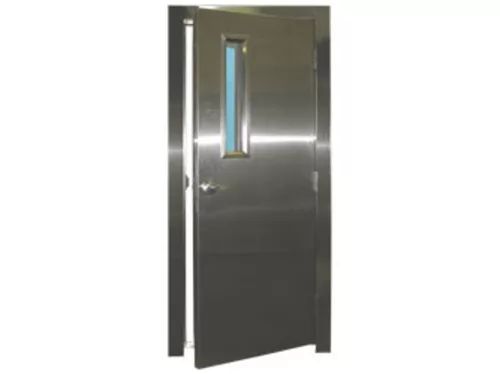fire door production process in YK Door Industry Co., Ltd.
As a leading steel fire door manufacturer, YK Door Industry Co., Ltd. applies cutting-edge techniques and rigorous quality control to ensure each fire-rated door delivers exceptional fire resistance and structural integrity. This article outlines the manufacturing process for metal fire doors, including the integration of modern materials and design innovations for maximum fire door production process.
Composition and Structure of Modern Steel Fire Doors

The core of a high-performance steel fire resistance door begins with a meticulously engineered frame. Typically constructed from hollow steel profiles, this frame forms the primary structural element of the fire door. The hollow structure not only reduces weight but also allows for the integration of thermal insulation materials that enhance the fire-retardant capacity.
Inside the steel frame, a specialized fire-resistant filler is densely packed. Common fillers include rock wool, vermiculite boards, perlite, or high-density mineral cores. These materials act as thermal barriers,significantly delaying heat transmission during fire exposure.
The exterior surface of the stainless steel fire door is treated with a fire-retardant coating. This layer, composed of non-combustible or intumescent materials, swells under high heat to create an airtight seal, thereby increasing the fire containment capabilities of the door.
Fire-Rated Hinges and Functional Hardware
Precision-mounted hinges are affixed at designated positions along the door frame. These hinges are not just mechanical connectors—they are critical safety components. At YK Door Industry Co., Ltd., we use fire-rated hinges with outer surfaces coated in fire-retardant finishes to prevent heat transfer and maintain mechanical strength under elevated temperatures.
Each door housing, made of hollow steel or other high-tolerance metals, is securely mounted to the frame via these reinforced hinges. The door leaf is similarly coated with fire-retardant compounds, ensuring that both structural and surface materials work in tandem during fire events.
A metal fire door is incomplete without functional, fire-rated accessories. The handle body, often manufactured from durable hollow stainless steel, is filled with non-combustible materials. This design resists deformation and heat conduction while preserving user operability. A fire-rated door lock is installed alongside the handle, designed to remain functional under extreme thermal conditions, securing the compartment and delaying the spread of flames.
Overview of the fire door production process
The assembly process adopted by YK Door Industry Co., Ltd. follows a structured methodology:
- Frame Formation: Hollow steel profiles are cut, shaped, and welded to create the main door frame.
- Insulation Packing: Fire-resistant fillers are densely inserted within the hollow sections of the frame and door leaf.
- Surface Treatment: Both internal and external surfaces receive fire-retardant coatings that are rated for varying fire resistance durations.
- Hinge Installation: Heavy-duty fire-rated hinges are installed precisely to ensure smooth operation and long-term reliability.
- Hardware Integration: Hollow metal handles, internal fillers, and high-security fire-rated locks are fitted, forming a complete steel fire door system.
- Final Assembly: The door leaf is mounted onto the frame via hinges, and the entire unit undergoes quality assurance checks, including dimensional accuracy and thermal resistance performance.
